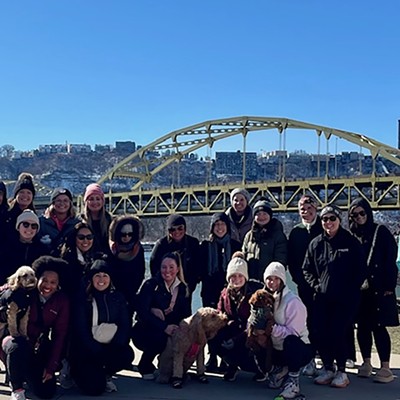"The issues really aren't conspiratorial, but basically mechanical," says Carlos Brossard, an independent political consultant from Highland Park, about the health of Allegheny County's voting machines. "Has the county kept records on the error rates of the machines? Records of maintenance or patterns of error? Has the reliability and validity of the machines been tested? Are they tested routinely or randomly?"
These are questions black Pittsburghers have quietly asked for years about their voting equipment, thanks to reports of machines malfunctioning in their neighborhoods. Mark Wolosik, chief of the Allegheny County Board of Elections, says there's little wrong with the lever system, but counties across the country are quickly replacing them. In 1980, over a third of all U.S. counties used lever machines. On Election Day 2004, just 13 percent will do so.
"I personally don't believe that the county places older, faultier equipment in black neighborhoods," says Louis "Hop" Kendrick, a top advisor for minority contracts and election matters to Allegheny County Chief Executive Dan Onorato.
In Pittsburgh's black communities, Kendrick is valued for his long record of knocking on doors and recruiting masses of new voters, long before it was called GOTV. After hearing complaints from black voters, he decided to write a letter to the county Board of Elections requesting answers to the sorts of questions Brossard asked. He didn't get a response. Right now election officials are swamped filing tens of thousands of new registrants, Kendrick says he was told.
Yet he remains confident that the county's 37-year-old Printomatic machines are accurate. The Printomatic, a 19th-century invention, is no longer being manufactured.
Even if Kendrick did receive a response to Brossard's questions, there is little data available from past elections. Wolosik says the county has only been keeping reports on the machines' care, maintenance and problem rates for the last few elections -- not even as far back as the 2000 presidential election.
The reason for concern: the so-called "under-vote," "drop-off vote" or, more accurately, "residual vote," which occurs when the number of votes in any one race is smaller than the number of voters, due either to voter choice or to malfunctioning machines. According to a widely cited study by the California Institute of Technology and the Massachusetts Institute of Technology, two million presidential votes were either lost or never cast in the 2000 election -- 1.5 million of which, the study says, were attributable to faulty voting equipment. When votes for governor and senator are included, the number of unaccounted votes due to machine problems balloons to 3.5 million, the study says.
Lever machines have the second-lowest residual vote rates, topped only by hand-counted manual paper ballots, according to the CalTech/M.I.T. study; the now more popular electronic voting machine systems had the highest residual vote rates. But lever machine voters showed the largest "drop-off" for votes cast in gubernatorial or senatorial races compared to the total number of voters: almost seven percent.
No empirical evidence is available to determine whether the drop-off is man- or machine-generated. According to Board of Elections director Mark Wolosik, it should never be pinned on the machines.
"You don't lose votes on any mechanical voter machine," he says. "The motor that opens and closes the curtain can burn out so that a curtain doesn't engage right [and] won't open, but that's the worst that can happen. Doesn't affect the vote, though."
That sounds nice, says Carnegie Mellon University computer science professor Michael Shamos, but "there have been plenty of instances where a machine's been opened and the counter will have all zeros" -- although he knows of no instances in Allegheny County. An under-vote is most likely, he says, because "either the voters didn't understand how to use a machine or made a conscious decision not to vote" in one or more races.
Voting machines that break down on Election Day, however, present their own problems. Given the machines' bulky size (imagine a cigarette-dispensing machine times three), problems can arise just in their transportation. Repairs require parts to be "scavenged," as Shamos puts it, from other machines just as old as the ones that break down.
Observes "Hop" Kendrick: "I'm more concerned with what happens when machines break down for a half a day and instead of waiting around [voters] go home and don't vote. I don't think anyone by design gives [black neighborhoods] more faulty machines but ... it might be our own fault if we don't have the extra commitment to put in that extra [time] to wait until it's fixed so we can vote."
The lever machines, says Shamos: "Eventually ... will all have to go." Wolosik says he'll use money allotted by the Federal Elections Commission to replace levers with touch-screen DREs (Direct Recording Electronic devices).
A machine's vote-recording ability is only as good as its technician. In Allegheny County, John O'Brien leads a team of 57 mechanics who've been working on the machines for years.
"We'll never find another system that lasts as long as this one," says O'Brien, head technician at the North Side warehouse that stores all 2,800 machines. "Show me a computer that's been around for 37 years."
Twenty days after the last primary, once the vote was certified (and legally not a day sooner), the technicians began tending to the machines: rolling the counters back, removing the programs, winding gears and running tests. About a month ago they began dummy election tests to make sure the machines are Nov. 2-ready. They'll be shipped out beginning on Oct. 30.
There have been problems in the past, O'Brien says, but usually because election judges don't know how to open the machines in the mornings.
"A lot of times you'll have the same problems at the same locations with the same judges," he says -- which may explain why people in some neighborhoods feel they have more problems than others.
O'Brien admits there have been plenty of problems in the 13th ward (Homewood and East Hills), but he blames them again on election judges and says the problems have had no effect on the vote. He also disputes rumors that the oldest machines are placed in black neighborhoods. All but a few of the lever machines in the city were assigned to their current locales when purchased in 1967.
The CalTech/M.I.T. study and others have recommended that the most heavily used machines be rotated to service in low-usage sites, and vice versa. While the county lacks even the data to effect such moves, O'Brien believes it would be "a complete nightmare" to re-label and re-program machines for that purpose anyway.
O'Brien also discounts the likelihood of machine counters stopping in the middle of Election Day. There are three counters in each machine: an inside and outside counter that are set back to zero after each election, and a "protective" counter that's turned back. If one counter breaks, the other counter is used. Final voter tallies are always checked against the protective counter. There's never been a case, says O'Brien, where even two of the three counters broke at one time on a single machine. But only recently, notes Wolosik, has the county begun keeping records of how often and where any counters break.
"My people come up to me all the time and say the machines break down in our community more than others," says "Hop" Kendrick. "I never believed in conspiracies, but I've heard them all my life -- and I seen it all, too. I seen blind people regain their sight on Election Day; seen the dead resurrected and had their vote count." Election officials, he says, "don't want these questions to continue to surface. If nobody provides details and answers" -- answers in the form of machine-use data -- "then it becomes suspicious. It needs to be put to rest once and for all."














